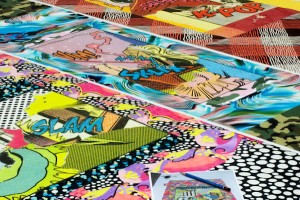
This week’s writing prompt asks you to think about the mashup, the remix, the “sample”–in short, the possibilities of the literary pastiche, a ground-up, reconstituted form of poetry that artfully (and sometimes not-so-artfully!) arranges found, borrowed and stolen language in innovative ways to make something wholly new. The idea for this prompt (not a new one, admittedly, as we’ve written many times about poems that use “found language” and their less bashful cousins, the full-0n centos) comes from Daniel Zalewski’s profile piece, entitled “The Hours,” about collage artist Christian Marclay. The article, which appeared last week in The New Yorker, discusses a broad array of Marclay’s work, the most famous of which is the twenty-four hour film “The Clock.” By stitching together hours upon hours of raw digital material sampled from all eras, genres and schools of film, Marclay collaged a full twenty-four hours of film matched to the real-time passage of the hours. In doing so, he
wondered if he could fashion from familiar clips a genuinely unfamiliar film, one with its own logic, rhythm, and aesthetics. In his view, the best collages combined the “memory aspect”–recognition of the source material–with the pleasurable violence of transformation.
The pleasures and pitfalls of Marclay’s efforts are not unfamiliar to artists in other realms of the creative arts. In literature, T.S. Eliot famously used pastiche in “The Waste Land” to issue a staggering modernist manifesto. So did Robert Hayden (whose voice you can hear on the Poetry Foundation Website), who took up similar tools to orchestrate the complicated voicings of “Middle Passage.” And today, postmodern poets, for whom sampling and “mixing” of high and low language (not to mention literary and non-literary influences) is so commonplace as to be a kind of convention, share this technique with a number of contemporary visual artists, filmmakers and musicians.
Ironically, though collage may appear to privilege–above all other things–the fragment or shard, what Zalewski’s article reveals is that the “key to [Marclay’s] video projects was the artfulness of the transitions, which reassure the viewer that a tactical intelligence controlled the flow of imagery.” At least for this artist, what distinguishes the mediocre from the truly artful is the quality of the “shaping,” or authorial impulses that guide the organization of the material, particularly at moments of transition.
* * *
Prompt: Write a literary collage of your own, drawing from a range of sources (the dictionary, an encyclopedia entry, tabloid magazine articles and/or classical works of literature) to find language that startles, especially when juxtaposed against one another. Focus particularly on the “seams” of the artifact, staging the appearance of each new linguistic element a way that reveals your overarching narrative or rhetorical intent.
For related prompts (from which this exercise “samples” unabashedly), check out the following writing prompts: The Cento, Semi-Cento or Found Poem | Borrowed Signs | Stealing